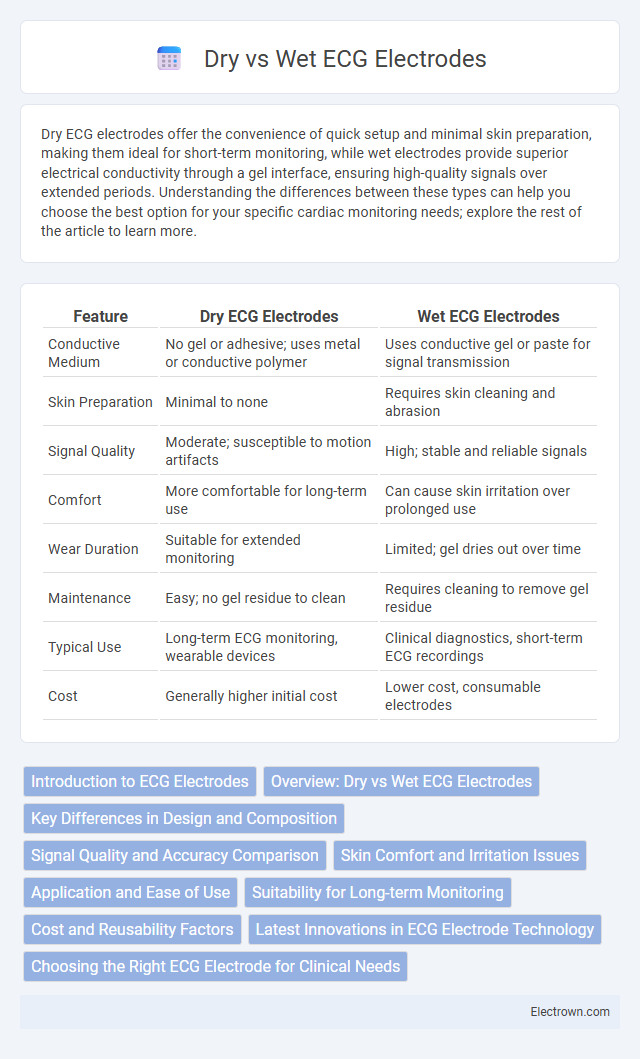Dry ECG electrodes offer the convenience of quick setup and minimal skin preparation, making them ideal for short-term monitoring, while wet electrodes provide superior electrical conductivity through a gel interface, ensuring high-quality signals over extended periods. Understanding the differences between these types can help you choose the best option for your specific cardiac monitoring needs; explore the rest of the article to learn more.
Table of Comparison
| Feature | Dry ECG Electrodes | Wet ECG Electrodes |
|---|---|---|
| Conductive Medium | No gel or adhesive; uses metal or conductive polymer | Uses conductive gel or paste for signal transmission |
| Skin Preparation | Minimal to none | Requires skin cleaning and abrasion |
| Signal Quality | Moderate; susceptible to motion artifacts | High; stable and reliable signals |
| Comfort | More comfortable for long-term use | Can cause skin irritation over prolonged use |
| Wear Duration | Suitable for extended monitoring | Limited; gel dries out over time |
| Maintenance | Easy; no gel residue to clean | Requires cleaning to remove gel residue |
| Typical Use | Long-term ECG monitoring, wearable devices | Clinical diagnostics, short-term ECG recordings |
| Cost | Generally higher initial cost | Lower cost, consumable electrodes |
Introduction to ECG Electrodes
ECG electrodes are essential components that detect electrical activity of the heart, converting it into signals for monitoring and diagnosis. Dry ECG electrodes use conductive materials without gels, offering convenience and quick setup for short-term monitoring but may face signal quality challenges during movement. Wet ECG electrodes employ conductive gels to enhance skin contact and signal conductivity, providing more accurate and stable readings ideal for prolonged diagnostic procedures.
Overview: Dry vs Wet ECG Electrodes
Dry ECG electrodes offer convenience and longer-term monitoring by eliminating the need for conductive gels, reducing skin irritation and improving user comfort. Wet ECG electrodes utilize a conductive gel to provide strong signal quality and lower skin-electrode impedance, making them the preferred choice for short-term, accurate cardiac monitoring. Your selection between dry and wet electrodes depends on the specific clinical application, monitoring duration, and patient comfort requirements.
Key Differences in Design and Composition
Dry ECG electrodes feature conductive materials such as silver, stainless steel, or carbon-coated polymers, designed for direct skin contact without gels, enabling quick setup and reduced skin irritation. Wet ECG electrodes incorporate a hydrogel layer saturated with electrolytes that improves electrical conductivity by enhancing skin-electrode contact, but may cause skin irritation or drying over prolonged use. The fundamental design contrast lies in dry electrodes' reliance on solid conductive interfaces versus wet electrodes' use of gel-based conductors for signal transmission.
Signal Quality and Accuracy Comparison
Dry ECG electrodes generally provide lower signal quality and accuracy compared to wet electrodes due to higher skin-electrode impedance and potential motion artifacts. Wet electrodes, with their gel interface, ensure better conductivity and stable contact, resulting in clearer, more accurate electrocardiogram recordings. For your diagnostic needs, wet electrodes are preferred when precise cardiac signal measurement is critical.
Skin Comfort and Irritation Issues
Dry ECG electrodes often cause less skin irritation due to their non-gel nature, reducing the risk of allergic reactions and prolonged discomfort. Wet ECG electrodes, although providing better signal quality, can lead to skin maceration and irritation from electrolyte gel and adhesive materials, especially during extended monitoring. Choosing electrodes with hypoallergenic properties and proper skin preparation can significantly enhance patient comfort and minimize irritation in both types.
Application and Ease of Use
Dry ECG electrodes enable rapid application without the need for conductive gels, making them ideal for continuous monitoring in ambulatory or emergency settings. Wet ECG electrodes require a conductive gel and skin preparation, which may extend setup time and cause skin irritation during prolonged use but provide stable signal quality for diagnostic-grade recordings. The ease of use of dry electrodes suits wearable and short-term applications, while wet electrodes remain preferred in clinical environments demanding higher signal fidelity.
Suitability for Long-term Monitoring
Dry ECG electrodes offer enhanced comfort and skin compatibility, making them more suitable for long-term monitoring without causing irritation or discomfort. Wet ECG electrodes provide high signal quality but may cause skin irritation over extended use due to the drying of conductive gels. For continuous cardiac monitoring, dry electrodes are preferred for their durability and reduced maintenance needs, while wet electrodes are typically used for short-term diagnostic procedures.
Cost and Reusability Factors
Dry ECG electrodes typically incur higher initial costs but offer excellent reusability, reducing long-term expenses in clinical and research settings. Wet ECG electrodes are generally cheaper upfront but involve recurring purchases due to their single-use design and the need for conductive gels, increasing overall operational costs. Cost-efficiency is significantly influenced by the frequency of use and the cleaning protocols required for dry electrodes versus the disposability and convenience of wet electrodes.
Latest Innovations in ECG Electrode Technology
Dry ECG electrodes now feature advanced materials like graphene and conductive polymers, offering improved signal quality and patient comfort without the need for gels. Wet electrodes, traditionally used for their reliable skin contact, are being enhanced with hydrogel formulas that minimize skin irritation and extend wear time. Your monitoring accuracy benefits from these latest innovations, enabling more precise diagnostics and continuous cardiac tracking in both clinical and wearable devices.
Choosing the Right ECG Electrode for Clinical Needs
Selecting the appropriate ECG electrode significantly impacts signal quality and patient comfort in clinical settings. Dry electrodes offer ease of use and are ideal for short-term monitoring or emergency situations, while wet electrodes provide superior conductivity and are preferred for long-term, continuous cardiac monitoring. Understanding the clinical context and monitoring duration is crucial to optimize diagnostic accuracy and patient experience.
Dry vs Wet ECG Electrodes Infographic

 electrown.com
electrown.com